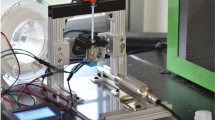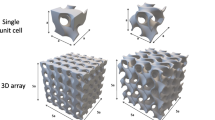Abstract
Equipment with complicated cooling channels are used more and more in industries. Due to limitation in size and shape, the heat dispersion of some key parts cannot meet the working requirements of equipment. To address failure in forming suspension structure directly and easy blockage of channels in additive manufacturing, this study proposed a research method that realized channel processing by using high-frequency induction as heat source and adding embedded pipe into melt deposition shaping. A multi-physical-field coupling finite element simulation model was constructed and an induction cladding experimental platform of shaftclass parts with embedded pipe was built. The high-frequency induction cladding manufacturing technology was studied from perspectives of macroscopic morphology and microstructure, element diffusion, temperature field distribution, and induction cladding technology of embedded tube. Results demonstrated that the maximum deformation rates of outer diameter and inner diameter of embedded pipe were 4.98% and 1.44%, respectively. The embedded pipe was influenced by molten pool and high-temperature cladding layer slightly, thus achieving good shaping quality. Therefore, the proposed manufacturing technology was feasible and it could solve technological bottleneck of insufficient heat dispersion capacity of equipment. Research conclusions can provide theoretical and technological supports to applications of additive manufacturing technology based on cooling channels and induction melting deposition to industrial production.















Similar content being viewed by others
Availability of data and material
The authors confirm that the data supporting the findings of this study are available within the article.
References
Santos EC, Shiomi M, Osakada K et al (2006) Rapid manufacturing of metal components by laser forming. Int J Mach Tools Manuf 46:1459–1468
Xiong L, Chuang AC, Thomas J et al (2022) Defect and satellite characteristics of additive manufacturing metal powders. Adv Powder Technol 33(3):103486
Shad A, Stache R, Rütjes A (2021) Effects of fumed silica flow aids on flowability and packing of metal powders used in Binder-Jetting additive manufacturing process. Mater Des 212:110253
Sachs E, Eylonis E, Allen S et al (1997) Progress on tooling by 3D printing: conformal cooling, dimensional control, surface finish and hardness. Proc 1997 Solid Freeform Fabric Symp 115–1241
Reggiani B, Todaro I (2019) Investigation on the design of a novel selective laser melted insert for extrusion dies with conformal cooling channels. TInt J Adv Manuf Technol 104:815–830
Wang XY, Guo HR, Wu YB (2011) Laser cladding fabrication of micro-fluidic channel mold of stainless steel. Chinese J Lasers 38(03):91–96
Armillotta A, Barggi R, Fasoli S (2013) SLM tooling for die casting with conformal cooling channels. Int J Adv Manuf Technol 71(1–4):573–583
Han S, Salvatore F, Rech J et al (2020) Abrasive flow machining (AFM) finishing of conformal cooling channels created by selective laser melting (SLM). Precis Eng 64:20–33
Torims T (2013) Laser cladding device for in situ repairs of marine crankshafts. Adv Mater Res 712–715:709–714
Zhang H (2018) Research on path planning and performance of typical cooling channel components based on research on path planning and performance of typical cooling channel components based on CMT additive manufacturing. FuZhou University
Kotsuka Y, Kayahara H, Murano K et al (2009) Local inductive heating method using novel high-temperature implant for thermal treatment of luminal organs. IEEE Trans Microw Theory Tech 57(10):2574–2580
Bidron G, Doghri A, Malot T et al (2020) Reduction of the hot cracking sensitivity of CM-247LC superalloy processed by laser cladding using induction preheating. J Mater Process Technol 277:116461
Meng XM, Bachmann M, Artinov A et al (2019) Experimental and numerical assessment of weld pool behavior and final microstructure in wire feed laser beam welding with electromagnetic stirring. J Manuf Process 45:408–418
Adamiec J (2009) High temperature corrosion of power boiler components cladded with nickel alloys. Mater Charact 60(10):1093–1099
Xia HJ (2007) Laser adjustment research for stainless steel sheet metal. Harbin Institute of Technology
Biswas S, Reddy GM, Mohandas T et al (2004) Residual stresses in Inconel 718 electron beam welds. J Mater Sci 39(22):6813–6815
Zhang JR, Zhao TY (1987) Handbook of thermophysical properties of materials commonly used in engineering [M]. New Era Press, Beijing
Funding
This research was financially supported by the National Natural Science Foundation of China (No. 51175515), Petro-China Innovation Foundation (Grant 2017D-5007–0307), and the Fundamental Research Funds for the Central Universities (No. 18CX05004A), and Natural Science Foundation of Shangdong Provincial (ZR2020ME162).
Author information
Authors and Affiliations
Contributions
Yongjun Shi: conceptualization, methodology, software, investigation, writing—original draft. Zhengfu Pei: validation, formal analysis, visualization, software. Biao Pan: validation, formal analysis, visualization. Xiaogang Wang: methodology, software, investigation. Kaijun Fan: formal analysis, visualization, software.
Corresponding author
Ethics declarations
Ethics approval
The author obliged all the rules regarding the ethics in publication.
Consent to participate
All the authors consent regarding the data provided in the text as well as the order of authorship.
Consent for publication
All the authors are consent regarding publication immediately after acceptance.
Conflict of interest
The authors declare no competing interests.
Additional information
Publisher's Note
Springer Nature remains neutral with regard to jurisdictional claims in published maps and institutional affiliations.
Rights and permissions
Springer Nature or its licensor holds exclusive rights to this article under a publishing agreement with the author(s) or other rightsholder(s); author self-archiving of the accepted manuscript version of this article is solely governed by the terms of such publishing agreement and applicable law.
About this article
Cite this article
Shi, Y., Pei, Z., Pan, B. et al. Research on high-frequency induction cladding manufacturing technology by embedding stainless steel capillary tube in shaftclass parts. Int J Adv Manuf Technol 123, 233–244 (2022). https://doi.org/10.1007/s00170-022-10079-5
Received:
Accepted:
Published:
Issue Date:
DOI: https://doi.org/10.1007/s00170-022-10079-5




